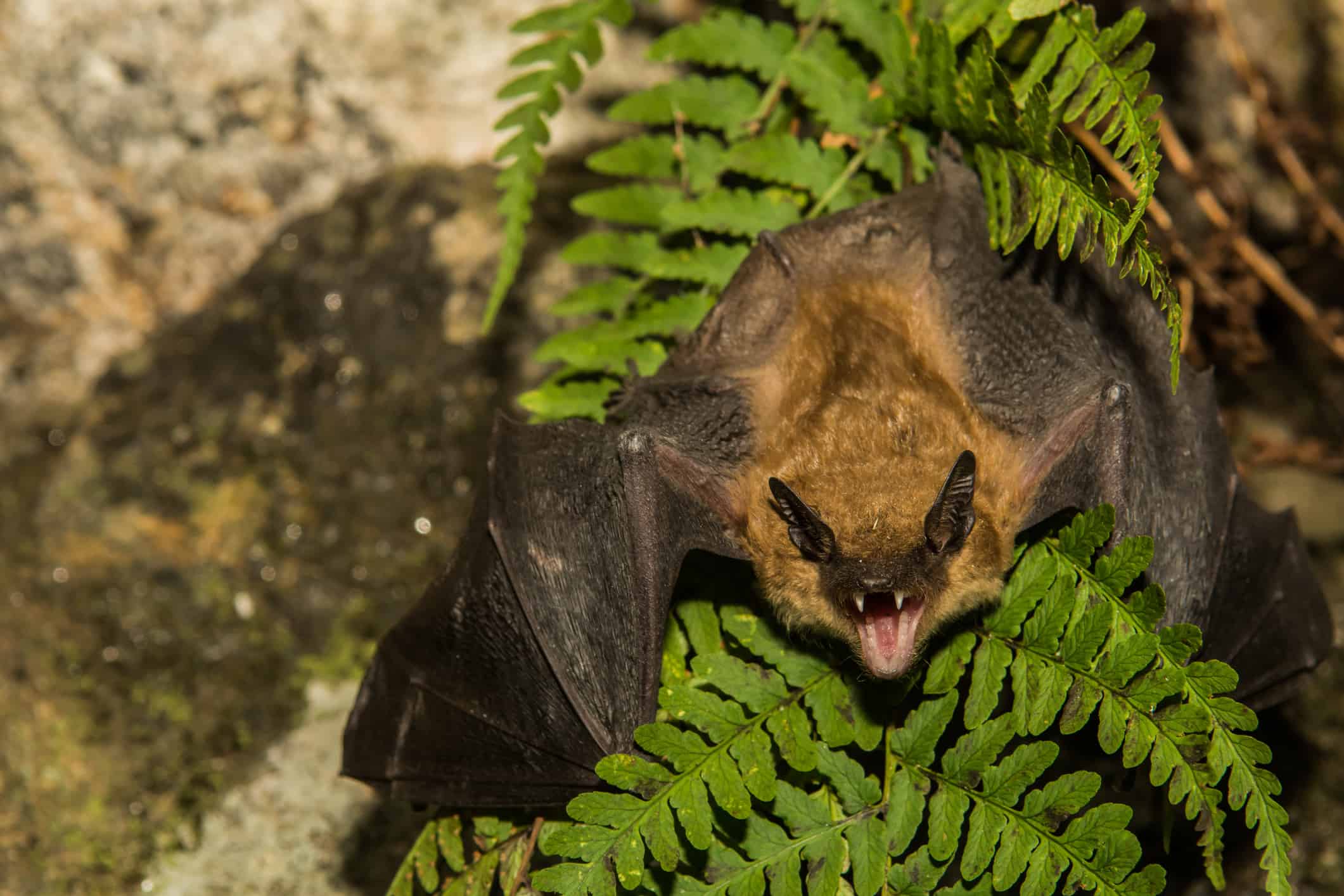Rabies is a viral disease of the central nervous system. It is most often transmitted through the bite of an infected (rabid) animal. This is because the viruses are present in their saliva (as well as their nervous tissue and some other organs). Symptoms in humans can start weeks or even months after the bite. If not treated, rabies in humans is always fatal. The only animals that can give you rabies are mammals – these are warm-blooded animals with fur/hair – humans are mammals. There are several different strains of the virus found in mammals. You cannot get rabies from a bird, reptile, or fish.
If a mammal bites you, get medical attention immediately in case you need treatment for rabies. Remember that you cannot reliably tell if an animal has rabies just by looking at it.
By understanding the rabies risk presented by different animals, you can take steps to keep yourself safe. Keep reading to find out eight animals that can give you rabies.
Bat

Bats are the leading cause of human rabies in the US.
©JasonOndreicka/iStock via Getty Images
Bats are the animals most likely to give you rabies in the US. Of the 89 human rabies cases contracted here between 1960 and 2018, 62 (70 percent) were caused by bat bites. What’s more, 1,241 bats tested positive for the virus in 2021. This is lower than that recorded in previous years. Over half of all the positive cases came from California, Texas, New York, Pennsylvania, Michigan, New Jersey, Illinois, and Minnesota. In contrast, no rabid bats were found in Alaska, Hawaii, or Puerto Rico. Among the positive species of bats were big brown bats (Eptesicus fuscus) and Mexican free-tailed bats (Tadarida brasiliensis).
Bats can give you rabies through a bite or a scratch, but these can go unnoticed because they are so small. Also, some people are unaware that you can get rabies from bats and do not get medical treatment after they are bitten. This is why contact with bats is the leading cause of human rabies deaths in the US. While bats aren’t usually aggressive, they bite if threatened. If you have to handle them, wear leather gloves!
Raccoon

Raccoons bite when they feel threatened.
©Vital9s/Shutterstock.com
Four people have contracted rabies from raccoons in the US since the 1960s. Racoon rabies started spreading during the 1980s and 1990s along the eastern seaboard and has spread westward since 2000. In 2021, a total of 1,030 raccoons tested positive, a lot lower than the peak of 5,912 recorded in 1993!
Twenty states, the District of Columbia, and New York City accounted for 96 percent of all rabies-positive raccoons. Most of the virus strains were the eastern raccoon type, but some were also the north-central skunk type.
Raccoons can set up homes in human garages and attics and will bite you if they feel threatened. This is how they transmit rabies. Rabid raccoons may be unusually calm but can also be very aggressive. They may have a discharge from their mouth or eyes and stagger around erratically, making a high-pitched noise. The best advice is to keep away from raccoons and call in experts to remove them if needed.
Skunk

Skunks are nocturnal but rabid skunks are often out in daylight.
©bobloblaw/iStock via Getty Images
There have been no reports of skunk-related rabies cases in the US in the last three decades, while three have been reported in Mexico. Nevertheless, the native skunk population remains a potential source of rabies. During 2021, 691 skunks tested positive, which is lower than in the previous five years. More than half were reported from just six states: Texas, North Carolina, Virginia, Colorado, Arizona, and Massachusetts. Unsurprisingly, they carry the north-central skunk virus strain but can also have the raccoon and bat strains.
All eight native skunk species in the US can get rabies, but the striped skunks (Mephitis mephitis) and some spotted skunks (Spilogale spp) are the main reservoirs of infection. Any skunk bite should be considered as exposure to rabies. Skunks with rabies are infectious before their symptoms start. Once the disease progresses, they act strangely. Striped skunks are primarily nocturnal, but rabid skunks are active during the day. They may also appear uncoordinated and aggressive. People have been bitten by skunks near their homes, at campsites, and animal enclosures. You can protect yourself by keeping your doors and tent entrances closed to prevent skunks from getting in.
Fox

Foxes that appear tame may actually have rabies!
©Giedriius/Shutterstock.com
In the spring of 2023, a rabid fox caused panic in New York by biting six people in the west of the city. Thanks to prompt medical attention, none of the victims were infected. Nevertheless, this incident illustrates the risks posed by rabid urban foxes in particular. In 2021, 314 foxes tested positive for the rabies virus in the US. Many were carrying the fox strains of the virus, but some were taking the bat strains. Meanwhile, other surveys have found that 3 percent of red foxes and 5 percent of arctic foxes carry the disease. People with hobbies or occupations bringing them into contact with foxes are at the most significant risk. Foxes with rabies often fight or bite inanimate objects – this is called ‘fly biting.’ They may appear very tame or aggressive. To avoid getting rabies from a fox, do not feed wild foxes!
Dog

Thanks to vaccination, very few dogs in the US now carry the rabies virus.
©iStock.com/Smederevac
Dogs are the natural host for a strain called the canine rabies virus, and they used to be the source of most human cases. Mass immunization programs for cats and dogs started in the US in the 1940s have eliminated this strain. These days, only 0.2 percent of dogs tested in the US carry the rabies virus (which amounts to about 35 cases a year) and are all wildlife strains of the virus. These include the north-central skunk and the bat viruses. Half of all the dog cases were from Puerto Rico, Texas, Georgia, and South Carolina.
Globally, however, exposure to rabid dogs is still the cause of most human cases. This means that your greatest risk of getting rabies is from imported dogs (100,000 dogs are imported into the US each year from countries where rabies in dogs is common) or when you are traveling outside the US. You catch rabies from infected dogs if they bite you. Dogs with rabies often show severe behavioral changes along with an unexplained paralysis that gets worse over time. During the so-called ‘mad dog’ version of the disease, dogs act very aggressively and use their teeth at the slightest provocation!
Coyote

Rabid coyotes are more likely to bite you but typically don’t survive long enough to get the chance!
©Mircea Costina/Shutterstock.com
In 2021, 9 coyotes (Canis latrans) tested positive for the rabies virus, which can carry several strains. This makes them a potential source, but reported human cases connected with coyote bites have not been recorded in recent years. That said, some coyotes are only submitted for testing because of unprovoked attacks on humans. Coyotes who had bitten someone were much more likely to test positive than those who had not.
This supports the theory that rabid coyotes are aggressive. This is concerning because coyotes are large animals increasing in numbers in states such as Massachusetts and are seen more often in suburban and urban areas. This increases the future potential for coyote-human transmission. As well as aggression, rabies symptoms in coyotes include loss of coordination, lethargy, and salivation. To keep yourself safe, avoid coyotes even if they appear ill or dead.
Cat

Cats in the US are more likely to carry the rabies virus than dogs.
©Oleg Elkov/iStock via Getty Images
Even though people do not usually associate rabies with cats, more feline cases are recorded than dog cases in the US. There were 216 cases of rabies in cats in 2021, which made up 1.2 percent of the cats tested. This is similar to the average of cases in the previous five years. Rabid cats were found in seven US states, including 48 in Pennsylvania and 28 in Texas. The cats were infected with several strains of the rabies virus, including the bat strain and the south-central skunk strain. Some states require pet cats to have a rabies vaccination, while others recommend it.
Cats usually get rabies from the bite of an infected wild animal. Cats with the most contact with wild animals are at higher risk of infection, so indoor cats are unlikely to get infected. If your cat is bitten by wildlife, speak to your vet because they may need a rabies vaccine or a booster shot if they are already vaccinated. Symptoms of rabies in cats include a change in behavior, aggression, drooling, and loss of muscle control. Cats can transmit rabies to humans by biting them or, rarely, scratching them.
Human

Infected organ donors can transmit rabies to recipients.
©carles miro/iStock via Getty Images
In theory, a human with rabies could bite another human and transmit the virus, but that has not been recorded. There are, however, reports of human-to-human transmission through organ donation. Transplanted corneas, liver, kidneys, and blood vessels have been implicated. The donors were not known to have rabies, but on further investigation, one did have a history of a bat bite.
As organ transplantation becomes more common, there may be a need for donor screening practices to be reviewed and for recipients to be closely monitored for signs of unusual diseases such as rabies.
Summary of Animals That Can Give You Rabies
| Number | Animal |
|---|---|
| 1 | Bat |
| 2 | Raccoon |
| 3 | Skunk |
| 4 | Fox |
| 5 | Dog |
| 6 | Coyote |
| 7 | Cat |
| 8 | Human |
The photo featured at the top of this post is © Jeff Reeves/Shutterstock.com
Thank you for reading! Have some feedback for us? Contact the AZ Animals editorial team.






